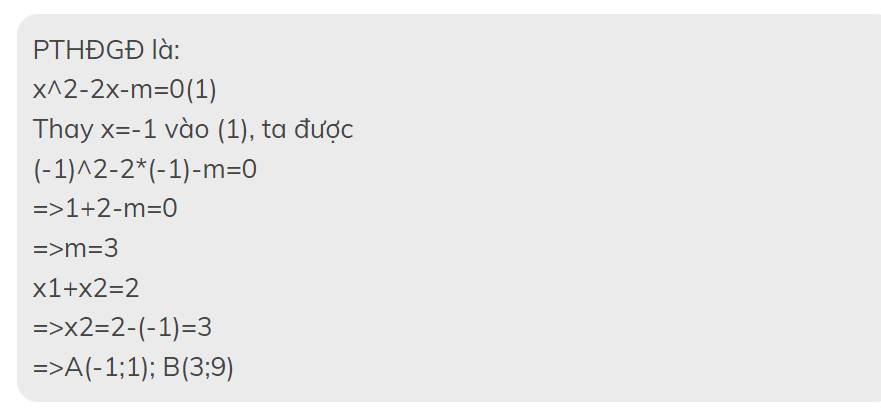Hãy nhập câu hỏi của bạn vào đây, nếu là tài khoản VIP, bạn sẽ được ưu tiên trả lời.

PTHĐGĐ là:
x^2-2x-m=0(1)
Thay x=-1 vào (1), ta được
(-1)^2-2*(-1)-m=0
=>1+2-m=0
=>m=3
x1+x2=2
=>x2=2-(-1)=3
=>A(-1;1); B(3;9)

Lời giải:
a. Để $(d)$ đi qua $A(1;0)$ thì:
$y_A=2x_A-m+3$
$\Leftrightarrow 0=2.1-m+3=5-m$
$\Leftrightarrow m=5$
b.
PT hoành độ giao điểm:
$x^2-(2x-m+3)=0$
$\Leftrightarrow x^2-2x+m-3=0(*)$
Để $(P), (d)$ cắt nhau tại 2 điểm pb thì $(*)$ phải có 2 nghiệm pb $x_1,x_2$
Điều này xảy ra khi:
$\Delta'=1-(m-3)>0\Leftrightarrow 4-m>0\Leftrightarrow m< 4$
Áp dụng định lý Viet: $x_1+x_2=2$ và $x_1x_2=m-3$
Khi đó:
$x_1^2-2x_2+x_1x_2=-12$
$\Leftrightarrow x_1^2-(x_1+x_2)x_2+x_1x_2=-12$
$\Leftrightarrow x_1^2-x_2^2=-12$
$\Leftrightarrow (x_1-x_2)(x_1+x_2)=-12$
$\Leftrightarrow x_1-x_2=-6$
$\Rightarrow x_1=-2; x_2=4$
$m-3=x_1x_2=(-2).4=-8$
$\Leftrightarrow m=-5$ (tm)
